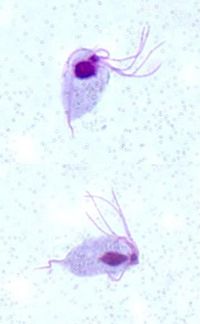Difference between revisions of "Trichomonas gallinae"
| (2 intermediate revisions by the same user not shown) | |||
| Line 1: | Line 1: | ||
| − | |||
{{Taxobox | {{Taxobox | ||
|name = Trichomonas gallinae | |name = Trichomonas gallinae | ||
| Line 53: | Line 52: | ||
<br><br> | <br><br> | ||
| − | + | This article was reviewed by Dr Tiana Tasca and Dr De Carli on 30/08/11. | |
| − | |||
| − | |||
| − | |||
| − | |||
[[Category:Miscellaneous Protozoa]] | [[Category:Miscellaneous Protozoa]] | ||
| − | [[Category:CABI Expert Review | + | [[Category:CABI Expert Review]] |
| + | [[Category:Expert Review Completed]] | ||
Revision as of 15:00, 2 September 2011
| Trichomonas gallinae | |
|---|---|
| Kingdom | Protista |
| Phylum | Protozoa |
| Order | Trichomonadida |
| Family | Trichomonadidae |
| Genus | Trichomonas |
| Species | Trichomonas gallinae |
Introduction
Trichomonas gallinae is the protozoal pathogen responsible for Avian Trichomonosis.
The parasite is identifiable microscopically by its four anterior flagellae and well developed undulating membrane on one side. T. gallinae has no posterior flagellum. Its body is divided by an axostyle.
The ellipsoidal or ovoid nucleus of the parasite is usually found in the posterior aspect of the organism.
T. gallinae requires sugars, starch and glycogen from host cells to survive and replicate.
Transmission
Trichomonas gallinae is present worldwide in wild birds particularly the pigeon and other Columbids. This trichomonad is also common in turkeys as well as in chickens and pet birds.
Transmission between pigeons occurs orally during feeding and mating behaviour. Survival in tap water for short periods ensures that the drinking water can be a source of infection for domestic fowl.
Transmission to domestic chickens and turkeys is achieved through contaminated water troughs that have been visited by wild birds.
Disease
T. gallinae causes "cankers", yellow, necrotic lesions and plaques in the gastrointestinal tract of birds, particularly in the crop and oesophagus. The upper digestive tract may be completely occluded, with large quantities of fluid accumulating in the crop. Among the rarer sites of infection are the spleen, kidney, upper respiratory tract and bone marrow. For more information see avian trichomoniasis.
| Trichomonas gallinae Learning Resources | |
|---|---|
 Test your knowledge using flashcard type questions |
Trichomonas gallinae Flashcards |
 Search for recent publications via CAB Abstract (CABI log in required) |
Trichomonas gallinae Publications |
References

|
This article was originally sourced from The Animal Health & Production Compendium (AHPC) published online by CABI during the OVAL Project. The datasheet was accessed on 2 June 2011. |
This article was reviewed by Dr Tiana Tasca and Dr De Carli on 30/08/11.
